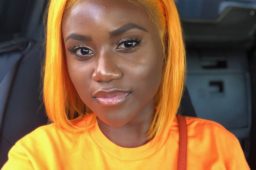10 Helpful Steps to Transitioning | Without the Big Chop
- July 07, 2020
- by
- AMG
Whether you’ve decided you want to make the transition from chemically straightened hair, heat or colour damaged hair to natural healthy hair, this post is for you. Contrary to popular belief, you don’t have to get up one day and shave your head or cut inches and inches of your hair to get back to natural and healthy hair, if you don’t want to. I didn’t.
Prior to me deciding to go back natural, I had kept my hair short for two years. (I had to cut it due to severe damage; for details on that whole story, check out my post – ,,My OG Growth Oil).
So when I finally decided to take the plunge, cutting it all off again wasn’t an option for me. I had to figure out how I was going to avoid doing the dreaded big chop.
Now, because the new growth is thicker, naturally you’re going to use more force to comb through that part, but the damaged hair is usually weaker and thinner and will get torn out if you use that same energy. This brings me to my first point –
1. Choose products that provide enough moisture and hydration to help keep the relaxed hair strong and the natural hair healthy and growing. To make detangling easier, products with high slip are essential during this time. (Slip is how “slippery” your hair strands are making it easier to comb through). It’s also important to use products that work for both the new growth and the relaxed/damaged ends.
I used: My #1 Leave-in – ,,Whole Blends Cocoa Butter Leave-in and my #1 daily moisturizer was ,,Palmer’s Olive oil hair lotion. Both of those are incredibly moisturizing and helps prevent breakage. Take your time when combing/ brushing your hair so that you’re not tearing hair out.
2. Deep condition weekly. You will notice a difference after a month of doing this. Alternate between protein and restoration treatments. The protein treatment I used for a long time was Motions CPR Protein Reconstructor, 16 Ounce” target=”_blank” rel=”noopener”>,,Motions CPR Protein Reconstructor.
One of my favourite deep conditioners is ,,Shea Moisture’s Jamaican Black Castor oil treatment. This will not only strengthen the strands of your hair but help with the growth and overall strength of your hair.
3. Wash your hair at least once a week with sulphate-free shampoo (unless you have in a protective style). If you allow dirt to build up, it will cause breakage and also clog your pores which hinders growth.
4. Pre-poo! Pre-poo-ing is basically prepping your hair before you wash and condition. You can cover your hair in oil or conditioner before using shampoo. This extra step in the washing process can sometimes seem like a hassle but makes a big difference. Even before I was going back natural, I used to do it to help my hair stay moisturized. It helps prevent the stripping of your hair’s natural oils.
5. Oil your scalp – this stimulates growth and helps with overall moisture. Check out my favourite oils ,,here.
6. The less heat, the better. As I mentioned before, your hair will be two different textures which makes it a bit harder to deal with. Blowdrying helps to even out the two textures which makes it easier to deal with. However, do not try to make your hair “pin-straight” and blow-dry only at low to medium heat. If your hair is frail and extremely damaged, I don’t advise you to put heat on your hair at all. My hair is very resilient, so I was able to get away with straightening on medium heat once a month. You shouldn’t be putting heat on your hair more than once a month, nor re-straightening pieces to freshen it up. The purpose of using heat is just to even out the two textures to make the hair more manageable till you’re ready to get rid of the dead weight. (To find a straightening routine that does the least damage to your hair, check out ,,my straightening routine, which I still use today.)
7. Now is not the time for dyeing and bleaching. I included this point because even though I had stopped using a relaxer, I continued to dye and bleach my hair. Needless to say, I ended up having to cut my hair all over again because it became damaged once again.
8. Pulling your hair back into a ponytail – it often seems like the easiest thing to do. But the excessively tight top knots, buns and ponytails, increases the likelihood of breakage and ruins your edges. In some cases, it even causes the hairline to recede. Stay away from those styles that cause the constant dragging of your hair strands.
9. Protective styles work. Putting your hair in cane rows (cornrows), braids, twists for a couple of weeks, is very good during this time. It relieves the stress of constant combing, tugging and pulling.
10. And big finish: you should trim your ends every 3-6 months. Just one or two inches should actually help speed this process along. Split/dead ends hinder growth and it’s not real length anyway.
And when it’s finally time to let go of those damaged, straight dead ends, don’t be afraid to just let them go. The great thing about hair is, it will grow back.
I hope this was helpful, let me know if there’s more you’d like to know in the comments.


#naturalhair #naturalhaircare #haircare #hair #transitioning #bigchop











2 Comments
Luther Fantazia
2nd Jan 2025 - 7:26 amGreat write-up, I am regular visitor of one¦s site, maintain up the nice operate, and It is going to be a regular visitor for a long time.
read more
19th Apr 2025 - 3:41 amSimply wanna remark that you have a very nice internet site, I like the design and style it actually stands out.